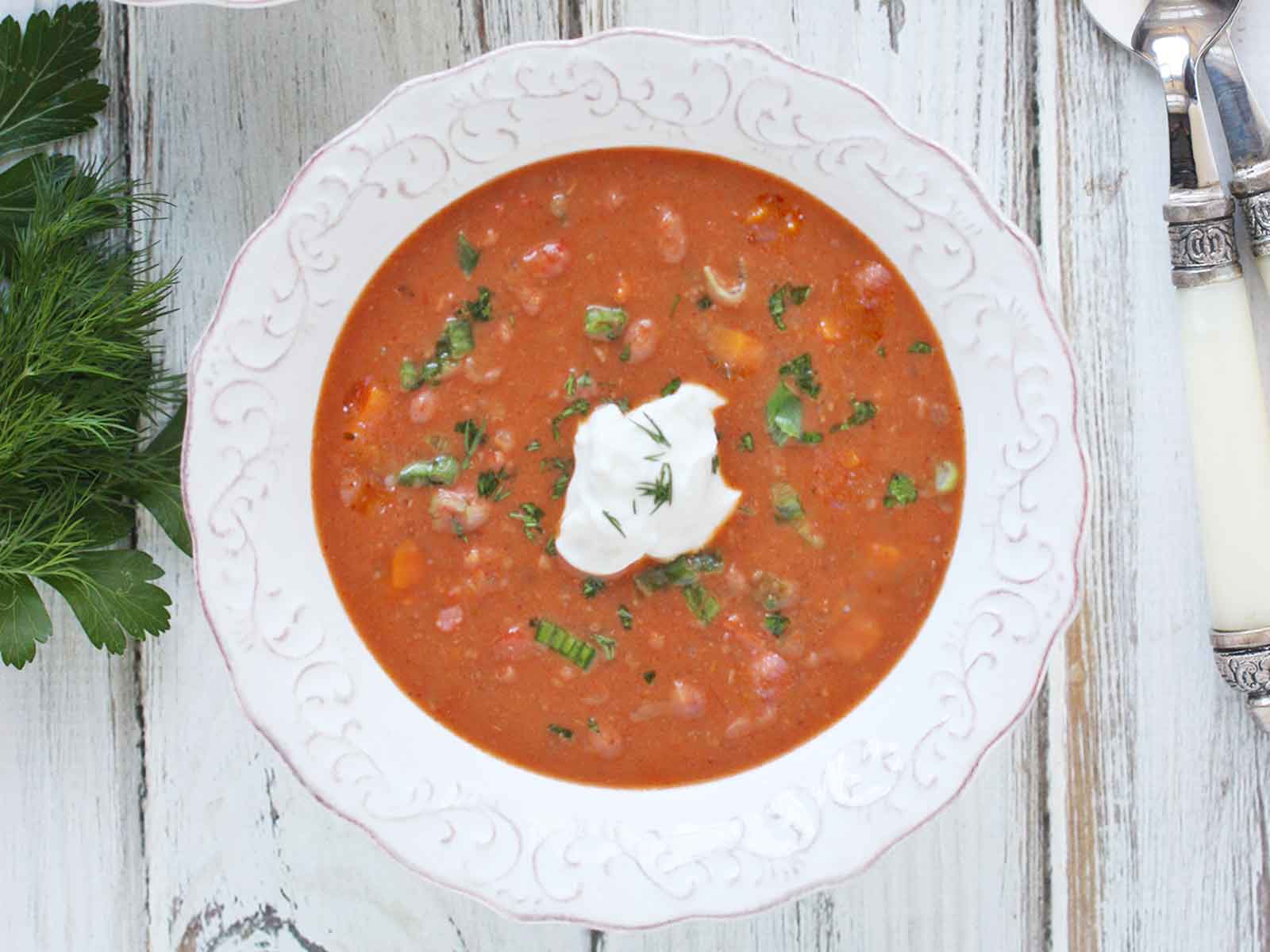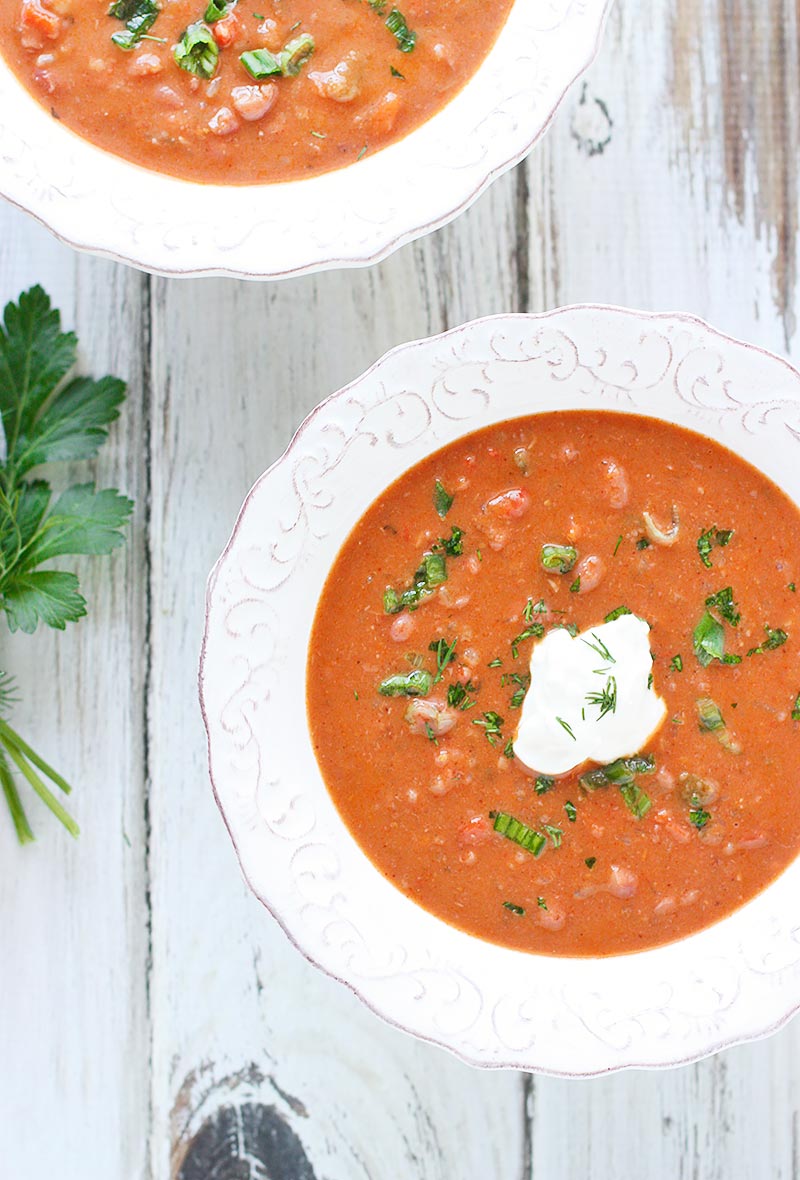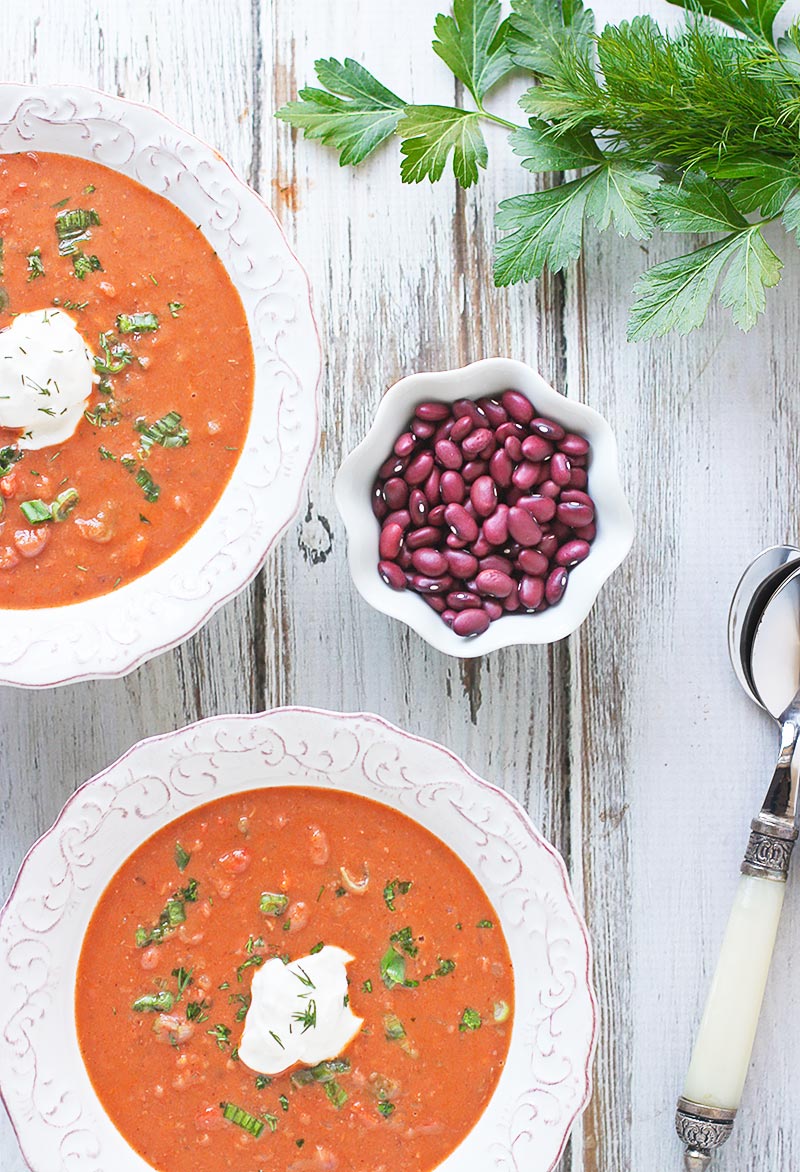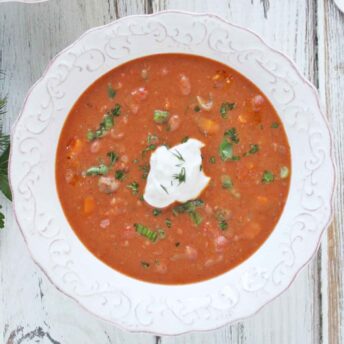Winter is finally here with claws extended — let this thick and hearty red bean soup, slow-simmered on the stove with lots of vegetables and spices, warm you from the inside out.

Happy New Year, food-loving friends! I hope the holiday season was kind, and that the strange winter weather has been as gentle for you as it has been here in the Ohio Valley.
Did you have a chance to see the new PBS special, Michael Pollan’s “In Defense of Food: the Movie,” which premiered late in December?
It’s a two-hour commitment, but one of things I respect most about the low-keyed Pollan is that he has the unique ability to summarize studies in sensible terms, report facts, express his views, and confidently reinforce his “eat more plants” dietary mantra without sounding smug or academic-preachy. He points out lots of things we’re doing wrong, but doesn’t shame us in the process.
If you don’t regularly follow food policy, or if you’ve never read his book of the same name, I highly recommend carving out some time to watch the program.

In the spirit of his prescription to eat real food, I’m sharing a delicious and healthy recipe for homemade, from-scratch red bean soup. I love cooking up a batch of soup, especially in the winter.
I find the process to be fluid, meditative, and multi-sensory. From the chopped fragrant vegetables to the sizzling oil to the steamy, bubbling broth, the act of creating a full-flavored soup is an enjoyable experience in the kitchen, and the result is comforting, satisfying, and health-supportive.
Red bean soup is a wonderful make-ahead meal, and its long simmer fills the house with those heady soup-making aromas of vegetables and spices. Some might wonder if you can use the shortcut of canned beans and an abbreviated cook time — and yes, you can — but I hope that at least once this winter you’ll give the full thing a go and take in the loveliness of a slow, home-cooked soup.
Cook’s Tips
- Don’t fret over the alarmingly large mound of diced onions you’ll produce. When onions are sauteed and then simmered for a loooong stretch, they turn sweet and practically melt into the dish, adding lots of savoriness in the process – no onion overload.
- Paprika is quite possibly my favorite winter spice. Here, I call for two types: smoked (Spanish pimenton), and sweet Hungarian. Note that paprika also comes in a hot variety, so if your jar says only “Hungarian Paprika” or even just “Paprika,” it’s probably sweet Hungarian. Hot is almost always labeled as such.
- Can this red bean soup be made vegetarian? Absolutely. Leave out the pork shank and use vegetable broth. The pork shank adds lots of flavor, though, so you might need to step up the salt and spices a bit.
- One-pot version: if you’re particularly averse to washing pots, you can do everything in one pot by switching up the order of the three main steps (after soaking the beans, of course). First, sear the pork shank (remove and set aside). Then, saute the vegetables and the spices, sugar, and tomato paste, as described. Then add the liquids (return the shank to the pot) and bring to a boil. Finally, add the beans, reduce to a simmer, and start the 2 1/2 hour cooking time at that point. Note that this method takes more time overall, because the beans will not have the cooking head-start that they receive with the two-pot method.
- For an interesting and very tasty BBQ variation, stir 2 to 3 tablespoons of your favorite BBQ sauce into the soup at the end. It scootches the soup into bean chili territory, especially when topped with the recommended sour cream and green onions.
What makes a really good soup great? Salt, acid, and time. It’s not unusual for a soup to taste a bit dull at the end of its cooking time. Even with superb ingredients, soup normally needs a boost to send it into lip-smacking goodness.

But don’t be too quick with the salt shaker. Did you know that soup’s best flavoring factor is actually time? Cooking ingredients in liquid efficiently releases their core essences, and a nice stint in the fridge lets those flavors deepen and combine in a way that no other technique can accomplish.
If you’re making this red bean soup ahead of time, hold off on doing the final tasting and seasoning until you reheat it for serving. You’ll find you’ll need to make fewer adjustments than you expected.
Then, salt enhances flavor, while acid – such as lemon juice or vinegar – pumps up the volume. If salting your soup isn’t finishing it off the way you want, try a nice squeeze of lemon juice. You’ll be pleasantly surprised at the effect.
Here’s to a new year of vibrant, real-food deliciousness, and I hope my red bean soup will make your menu soon!


Slow-simmered Red Bean Soup
Ingredients
For the overnight soak
- 1 lb. dried small red beans about 2 cups
- 8 cups water
For the soup
- 1 to 2 cups low- or no-sodium chicken or vegetable broth preferably homemade
- 1 pork shank about 3/4 pound
- 2 tablespoons olive oil
- 1 large onion diced
- 1 carrot peeled and diced
- 1 small red bell pepper diced
- 1 small green bell pepper diced
- 2 ribs of celery diced
- 3 cloves garlic minced
- 1 tablespoon smoked paprika
- 1 tablespoon Hungarian sweet paprika
- 2 teaspoons chili powder
- 1 teaspoon ground cumin
- 1 teaspoon brown sugar
- 1 heaping tablespoon tomato paste
- 1 bay leaf
- 1 splash red wine vinegar
- 1 teaspoon dried herbs such as marjoram, oregano, or an Italian blend
- 1 tablespoon chopped fresh parsley and/or fresh dill
- sour cream or Greek yogurt for garnish
- chopped green onions for garnish
Instructions
Soak the beans
- The night before – or at least 6 hours before – the cook, add rinsed beans to a large bowl, pick them over for debris or broken pieces, and cover with 8 cups of water. Let soak on the counter for a minimum of 6 hours.
Cook the soup
- Set a 4 or 5 quart stock pot or Dutch oven over high heat. Transfer the bean soaking water to the pot, measuring it as you go. You’ll need 6 cups of liquid (the soaking water will probably amount to 4 or 5). Use broth to make up the difference. Let the liquid come to a boil, then add the beans, reducing heat to maintain a steady simmer (meaning, bubbles will break the surface at a perky, but not frenetic, pace). Cover the pot with a lid, or foil.
- While the beans begin their long simmer, heat 1 teaspoon (yes, teaspoon) of oil in a roomy saute pan over medium heat. When the oil begins to shimmer, place the pork shank in the center and sear, turning the shank with tongs every few minutes or so until all flats sides have been browned. Transfer the shank to the bean pot, and recover the pot.
- There will be some fat in the pan – add up to 1 tablespoon of the oil (just eyeball it – there should be a thin, even film over the bottom of pan) and allow to heat until shimmering. Add the onions, carrots, peppers, and celery, and saute until all are soft, about 10 minutes, then mix in the garlic and stir until the garlic is fragrant.
- Scootch the vegetables to one side of the pan and add the remaining oil to the cleared spot. Measure the paprikas and cumin directly into the oil and stir to make a paste (add a blot more oil if too dry). When the paste is fragrant, add the brown sugar and tomato paste, and stir all into the vegetables. If the vegetable mix is sticky or seems dry, add a couple of tablespoons of the bean soup liquid to the pan. Continue stirring the vegetables until they are well-coated with the spice and tomato paste mixture, then scrape into the soup. Toss in the bay leaf.
- Tip: if the pan has lots of browns bits stuck it, deglaze it with a splash of red wine or soup liquid and scrape that into the bean soup pot, too.
- Cover completely and continuing simmering for one hour (the beans should have been simmering for about a half hour at this point, so, a total of 1 1/2 hours).
- Give the soup a stir, and add the vinegar and dried spices. Re-cover with the lid askew, and continue simmering for another hour.
- Remove the pork shank and fish out the bay leaf.
- For a thicker soup, transfer about 1 cup of the beans to a mixing bowl, along with a tablespoon of the soup liquid, and puree with an immersion blender or mash with a fork. Stir back into the soup, along with the chopped parsley. Taste, and add salt as needed. Let the soup rest on low heat for 15 minutes before serving.
Serving suggestions:
- Serve in extra large mugs (like the crazy big latte mugs from the 90’s), topped with a dollop of sour cream or yogurt, and a sprinkling of green onions, with a toasty baguette on the side.
- Spoon over brown rice or noodles, with more fresh parsley.

Bella
Friday 13th of December 2024
Do you have a preferred substitute for pork shank? I can't find it in my local stores.
Karen - SoupAddict
Friday 13th of December 2024
Isn’t that crazy? I’ve had so much trouble finding pork with their bones. Look for a ham hock, or as a last resort, any cut of ham with the center bone, even if it’s just a thick ham steak. You could trim some of the good meat away and use for another recipe (it will freeze well) and use the bone with some of the meat.
Brenda
Saturday 4th of February 2023
Can you please post the nutritional info including the calories? Thanks!
SoupAddict
Saturday 4th of February 2023
I no longer include nutritional values because it depends entirely on the brands or variations you use, and specificity is often important. There are nutritional calculators available on the web that align with your dietary needs.
eli
Saturday 6th of March 2021
so good! definitely recommend the di and sour cream